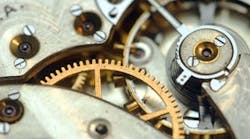After growing its business throughout Western Europe, Rattunde saw an opportunity in North America. The machine builder founded a subsidiary in Grand Rapids, Mich., in 2006, pretty much in conjunction with the first machine launch into the North American market, according to Richard Stadler, president of Rattunde's North American headquarters.
Rattunde will not put machines into locations that it cannot support fully, Stadler says, so the company has held its markets primarily to Western Europe and North America. "We still have a great deal of interest in our machines in other markets—India, Asia, South Africa," he adds. "There's a lot of interest to put machines in these areas, but we simply won't sell machines into markets that we can't support."
Rattunde is exploring other markets, however. "Our current effort is to expand further into Eastern Europe," Stadler says.The company also is exploring expansion into South America.
Rattunde sells many of its machines to horizontal markets such as bar or tube producers, which serve a wide range of industries. Products made could include any number of items such as small-engine or exhaust components, automobile ride control components, airbag canisters, hydraulic cylinders and piston rods, bearings, and conveyor rollers.
The automotive industry, for one, is always pushing automation, calling for tighter tolerances. "They are also pushing more exotic materials as the CAFE (corporate average fuel economy) standards have been forever increased for lighter cars," he says, explaining that many of the new materials are more difficult to cut. "And you want minimum scrap as the materials get more expensive."
Otherwise, Stadler says, innovations are driven by the need for a reduced footprint and a better return on investment. A work cell needs to be able to produce more, and have a fast changeover as production runs become shorter and changeovers become more frequent.
The majority of machine improvements have come through requests from customers, Stadler notes. But in addition to an engineering group that's responsible for the day-to-day engineering tasks, Rattunde also has an advanced design team in Germany that comes up with ideas that will be implemented further down the road.
Although some Rattunde machine models compete with a number of cut-to-length and OD/ID facing machines, the most recent innovation, the ACS+CFMcurve production center, is unique to the industry. It controls up to six servo axes to radially move the tool holders, notching, contour machining, threading, and creating a range of complex shapes. "We have a patented method to move the tool holders so there is very precise control of cutting inserts while moving the spindle. Whatever tool you put into those insert holders, you're able to accurately and repeatedly control that tool and accomplish an almost unlimited number of additional processes when it comes to machining," Stadler says, explaining that the tool holders can be adapted to a variety of bars and tubes through servo programming. "We are able to do things that have never been done before with this type of device. You would normally need multiple machines."
As one example, Cosmos Manufacturing in South Chicago Heights, Ill., used to run two or three different saws to complete its work on small-engine exhaust tubes for outdoor power equipment. Now the work is done with just the Rattunde system that cuts, measures and brush deburs mill-length tubes. It produces up to 11,000 parts per hour—triple the previous output at Cosmos, according to Mike Jemilo, the end user's general manager.
Rattunde has always relied on servo control of its machines, Stadler says. Design goals from the beginning have included minimal to no operator intervention. "We want everything to be controlled by the machine," he says. This means no hand wheels, no adjustable handles or slides. All setup parameters on a machine are controlled automatically and saved to a unique part program.
All of Rattunde's machines are controlled by a Siemens Sinumerik 840D CNC system, including Simatic S7 PLC and Siemens HMI. "We've controlled up to 38 axes on one NC controller," Stadler says, adding that they've only recently begun adding additional numerical control units (NCUs) to support more axes. "We're using all 10 channels on the NCU and pushing the control capability to some extreme limits, but have seen absolutely no problems in signal degradation or processing speeds."
The CNC, PLC and HMI all are programmed within one software environment, Stadler notes. "Every end of the machine, every motion, every input, every output is controlled by the integrated control system."
Since last year, Rattunde has begun using integrated safety systems from Pilz. "We used to hardwire the safety devices directly to the master control relay," Stadler notes. "If anything in this simple safety circuit would open up, the MCR would simply drop out." Now the safety components all talk to each other through an advanced safety control system. Rattunde also is using encoded magnetic switches rather than simple key switches. The overall level of safety on the machines is better, and Rattunde is able to provide the operator with a higher level of information.
Each machine is networked with its own IP address, and is shipped with a hardware firewall to give Rattunde direct VPN tunnel access for remote maintenance. "In addition to that, for certain areas that we allow, a parallel LAN network can be configured so customers can connect to the PCU side of machine to access and back up all the machine data," Stadler says. "Every part ever made has vital data written to a text file. We can analyze the productivity of that part, including machining torques, sawing parameters, length measurements, production rates."




